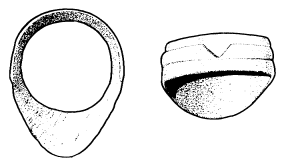
Register a SNAP EBT card with Amazon

by C N Hammersley
Part Three - The Tartar Wars
Miniature Wargames 1997
This the third of three articles on Ivan's campaigns, is somewhat different from the first two in that it is concerned with the Tartar Wars fought between 1499 and 1503. The Tartars participated in the full campaigns of their European allies (See previous articles), but they also fought related campaigns amongst themselves. It should be noted that both Lithuania and Muscovy had Tartars subjects, however, this article is concerned with the independent Hordes and covers the Tartar raiding, banditry and inter Horde warfare which had an influence on Ivan's other campaigns.
The Hordes in which we are interested in are the Golden Horde, allies of Alexander Grand Duke of Lithuania, the Krim, allies of Ivan III, and Kazan, which although an enemy of the Golden Horde was no friend of Ivan's. It should also be noted that in the no-mans-land of the "Wild Plain" or "dikoe pole", many bands of Tartar roamed professing no allegiance to any one Khan, but were led by their own chief's, one such was the Azov Horde.
To give you some background into these Tartar groupings I have prepared a short history of each and hope this will make clear some of the tangled relations they had with one another: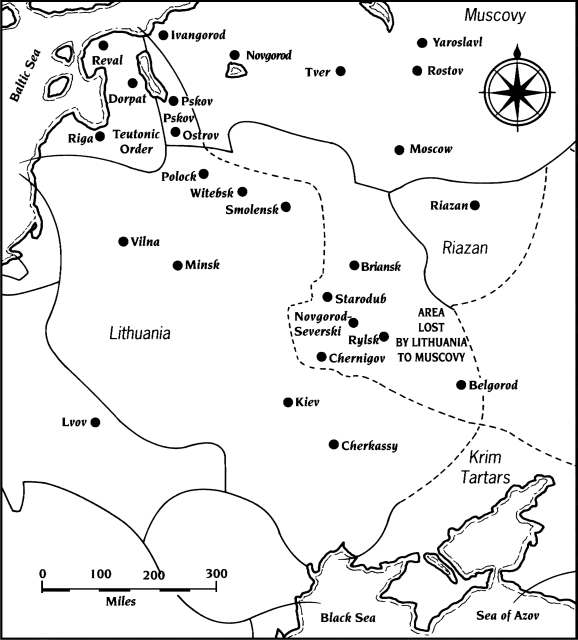
The Golden Horde
The Golden Horde dated back to 1251 when Genghis Khan's grandson, Batu Khan, established his rule in his tented capital of Sarai. Batu's tent was gilded, hence the name Golden Horde. The Horde broke away from the Mongols of Karakorum in 1266 and later, in 1340, became followers of Islam, well superficially anyway. During a great part of this time it held vast areas of land in the East and in Russia, however from the mid-fourteenth century it began to decline. In 1430 the Krim split from the Horde, as did Kazan in 1445. At Astrakhan, in 1466, a rival khan set up court, and in 1480 Muscovy successfully challenged its Tartar overlords, at the battle for the Ugra Fords, and stopped paying tribute to Sarai. After this the Horde continued to exist but was constantly trying to regain its former power.
The Krim Tartars
At this date the Krim Tartar Khanate was one of the most important states in Eastern Europe.
They were vassals of the Ottoman Sultan, and had been so since 1475, but they were no primitive enclave on the Northern shores of the Black Sea. The Tartars who had migrated to the Crimean Peninsula had adopted a semi-settled way of life and enjoyed the security it provided. It possessed a viable government with a central administration, a legal system based on the Ottoman example and had a high urban population, when compared to its Russian neighbours, it built both secular and religious buildings, produced written histories and had an educational system superior to Muscovy. Its economy was dependent on trade in agricultural products, livestock and most of all slaves captured in its northern campaigns. These raids had a severe effect on the Russian and Lithuanian lands, turning vast areas into an under populated, battle-torn, no-man-land. The fact that the Tartars were Muslim and therefore forbidden to touch pork induced many poor Slav farmer to breed pigs.
The Kazan Horde
The Kazan Horde was directly east of Moscow and was always considered a back door threat to Muscovy. Forcing Russian armies back from the Lithuanian front to cover possible invasions, many times. It was constantly at war with the Golden Horde and often suffered from internecine wars within its borders, the losing Khan fleeing to Moscow for succour (See first article and the Kazimov Horde).
The Azov Tartars (or Cossacks)
The Azov Tartars were also known as Cossacks, but at this period they were definitely of Tartar stock. Cossack, in this instance, can be taken to mean Kazak, the Tartar word for comrade, and is now used as a tribal grouping, such as found in the name of modern day Kazakhstan. The Azov Tartars were probably originally Nogai Tartars. The Nogai closely resembled the Mongols, being small, copper coloured and with flat faces (Monguts or "Flat- noses"). By our period influences from the Circassian's and the other Tartar peoples had appeared. The Azov had broke with the Golden Horde early and roamed the "Wild Plain", from the banks of the Don down to the town of Azov, which was in Ottoman hands. The Azov Tartars were not subjects of the Sultan, in fact they were often in conflict with the Porte, forcing the Krim Khan, who was a vassal, to station a body of horse-men at Azov to protect the caravan trade.
As recorded in the first article, Mengli-Girey, the Khan of the Krim Tartars, declared war on Lithuania in 1499 as ally of Ivan III, Grand Duke of Muscovy. In 1501 Saih-Ahmed, the Khan of the Golden Horde, declared for Grand Duke Alexander of Lithuania.
In 1500 the Krim's ambassador to the Muscovite court was travelling with Prince Kubinskii, Muscovy's ambassador to the Krim, across the steppe with a large cavalry escort, it was intercepted by a larger force of Azov Tartar's and attacked, only the Russian ambassador and fifty of the escort managed to escape.
The start of 1501 continued badly for Ivan and his Krim allies, the Muscovite ambassador to the court of the Krim Khan was captured by another attack by the Azov Tartars, while crossing the steppe. During the summer Saih-Ahmed occupied Rylsk and advanced as far as Briansk. In the north the Teutonic Order was attacking Pskov. To ease some of this pressure and to stop him from having to fight simultaneously on so many fronts Ivan attempted to buy off Saih-Ahmed with promises of the resumption of tribute payments along with the arrears (the payments had stopped some time before 1480). In November, also in the north, Ivan sent an, army of 100,000 Russians along with a force of 30,000 Krim Tartars, to attack the Teutonic Order. This huge force defeated the order's army at Helmed and went on to devastate a large tract of Livonia.
In 1502 Mengli-Girey personally led an army against the Golden Horde. In June he routed Saih Ahmed and his army, forcing the Khan and a few companions to flee for safety. Thus at a single stroke the Golden Horde was destroyed. Mengli-Girey then continued north entering Sarai, the Horde's capital, and partially destroyed it. Sarai at this time had grown rich on the caravan trade and the tribute of earlier years, in 1333 it had a population of 200,000 souls and had brick and marble buildings as well as the more familiar Tartar tents. It had fine mosques, public baths and a mint, but coins were always of secondary importance to barter in the Horde's economy.
Saih-Ahmed had at first gone to Belgorod and the Nogai Tartars for help, then on to Astrakhan, and finally to the protection of his ally Grand Duke Alexander. However, without troops Saih-Ahmed was little use to Alexander and was finally murdered in 1505, on the orders of Alexander, so as to seek favour with Mengli-Girey.
Ivan on hearing of Mengli-Girey's victory began rushing messages to the Crimea, urging the Khan to launch a major attack on Lithuania without delay. He had his own troops advance and occupy those areas of Chernigov which were formerly held by the Golden Horde. Ivan proposed that Mengli-Girey should send his men, via the old raiding route, northwards to Kiev and then on to Minsk, but then to turn north-east so as to be able to join up with the main Muscovite force which was besieging Smolensk. The Tartar army had already set out, three days before Ivan's message arrived, led by Feti-Girey and Burnash-Girey two of the Khan's younger sons (the Krim Khan's eldest son was always held at the Sultan's court to ensure loyalty). The Tartar army numbered some 90,000 and was one of the largest forces the Krim had put together. Mengli-Girey acted at once sending out riders to intercept the warriors with his new orders. Mengli-Girey also planned that after Smolensk, Vilna would be next.
The riders caught up with the Krim army and passed on the message, however, upon reaching the mouth of the Dnieper River the army spent the month of August camped there. At the beginning of September they advanced inflicting terrible damage, burning, looting and fighting the scattered Lithuanian forces. They then swept across southern Poland, reaching as far west as Cracow. No attempt was made however to link up with the Muscovites. The reason behind this was probably the Tartar's fear of woodland. The Tartar was a horseman fighting an enemy at a distance with the bow, tactics totally unsuitable to the thickly forested areas they were now skirting. So Ivan's plan came to nothing. It must be said that the Tartar expedition nevertheless gave Ivan valuable support, diverting Polish and Lithuanian efforts away from Smolensk, who upon hearing of the Tartar invasion advanced against them instead of Ivan's troops. The Tartars withdrew at the end of the campaigning season.
During 1502, Alexander had twice made attempts at peace with the Krim, promising to pay Mengli-Girey an annual tribute, if he would stop his raids. Mengli just sent these pleas on to Ivan without bothering to reply, especially as this was the time his two young sons were successfully raiding the southern parts of Poland and Lithuania. In 1503 peace was made between Ivan and Alexander, it did include the Krim, but they continued a low key campaign of raids, which for them as an end to formal hostilities.
Tartar Military Organisation
Among the hordes there was no distinction between soldier and civilian, every able bodied Tartar male who could sit a horse was expected to serve his khan. He was equipped and trained as a horse archer from early age, being able to ride almost before he could walk. The Tartar lived for war, his livelihood was dependent on campaigning, raiding and war, which was used to augment his wealth from the rearing of livestock. For such people the waging of war in far-flung campaigns was not out of the ordinary and effected little their daily habits, this migratory habit was dependent on the availability of water and good pasture for their flocks and herds.
The Tartar was first and foremost a mounted archer, certainly for the campaigns I have written about the forces were 100% cavalry. Armed primarily with the composite bow, they could strike quickly into enemy lands and vanish again as quickly. As has been said, a bow, sometimes two were carried, also a sabre, dagger and spear (though the spear appears to have been a sign of rank, certainly by later times) which had a large hook behind the blade for unseating an enemy horseman. In addition to these the lasso, axe, wooden or iron mace and fire pot could be found as part of his equipment. The fire pot was a hand thrown incendiary device, similar to a modern hand grenade, made of clay which would shatter on impact spilling its burning load. Shields were also carried and were usually round but the Ottomans had begun to introduce the Hungarian style wing-shield by this period.
FIRE POTS
These ceramic grenades contained 'Greek Fire', the exact nature of its ingredients are not known. What was known for certain was that it was a liquid, it was made from sulphur, charcoal, crystalline saltpetre and a byproduct of petroleum, in what quantities and with what else is not known.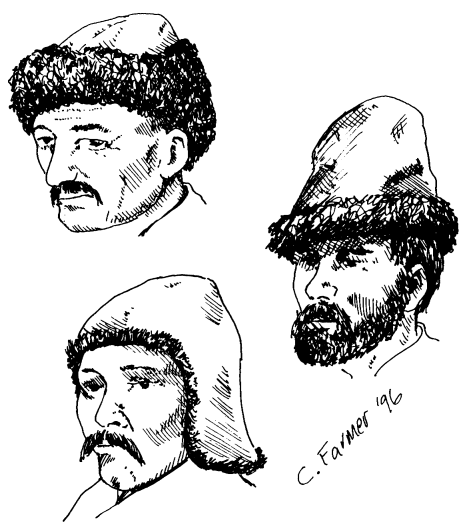
The horseman wore little or no armour, maybe a helmet, but more likely a fur trimmed hat. Some Tartar helmets were iron casques but many were of leather, having a back flap covering the nape of the neck and side flaps to cover the ears. Boots, linen trousers and an ankle-length kaftan would have made up the rest of the outfit. The general appearance was grubby, if western witnesses are to be believed. Some Tartar leaders wore a more "western" (Polish) style, red or yellow boots and some mail, but the other influence would have been Ottoman with the use of a turban. Dress, however was far from uniform, and certainly it was not uncommon for them to be returning from a long and unsuccessful foray in rags, barefoot and starving.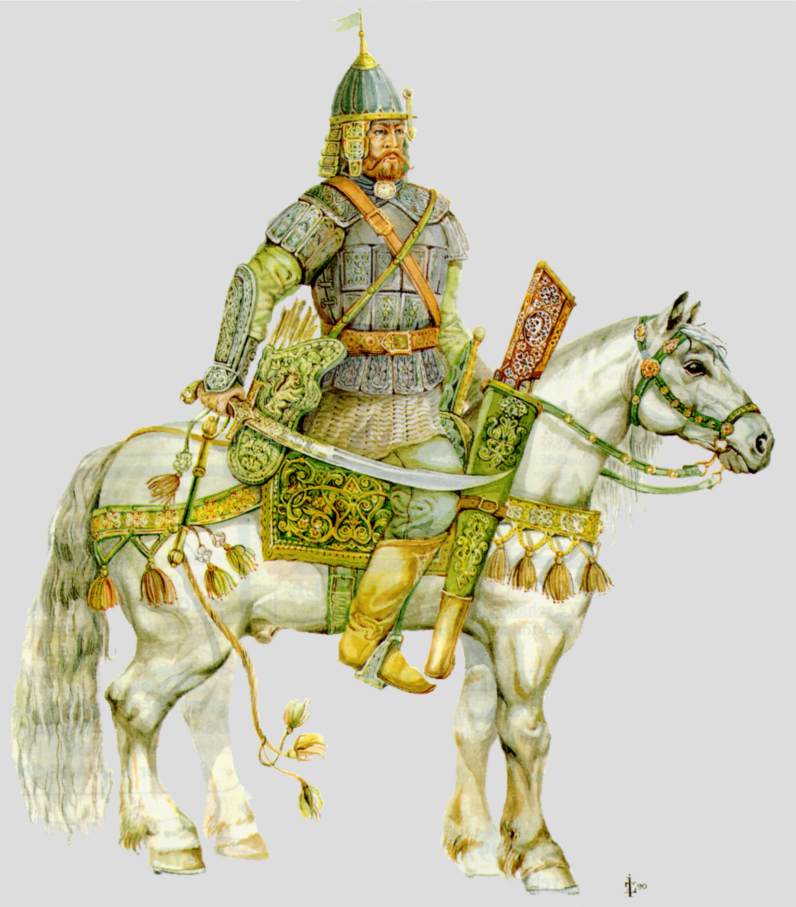
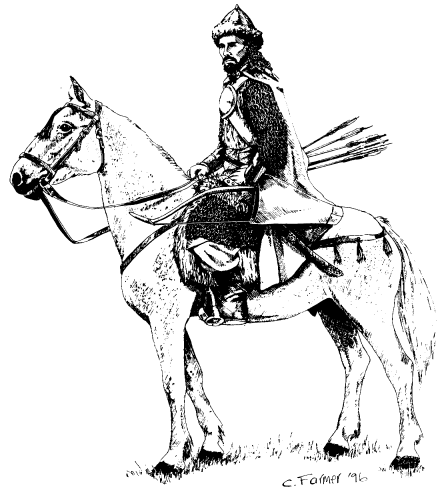
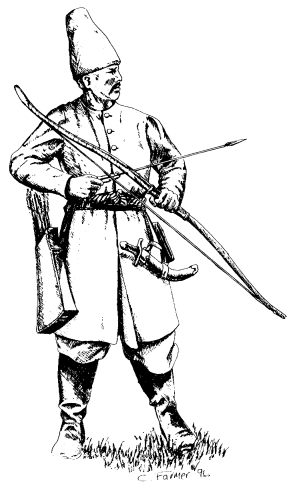
The Tartar horseman never wore spurs instead he carried a whip on a short stock hung from a loop from his wrist. He very rarely used the whip preferring to yell Hoida!! to encourage his mount on. Stirrups were worn very short almost jockey-fashion.
Tartar horses were barrel shaped, with short strong legs, a heavy head and short neck. Generally small they were rarely more than twelve or thirteen hands high, it also had a dense coat which was useful for life on the steppe, and it could survive on the poorest of grazing. Bays, greys and reddy browns were the usual colours. They bore some resemblance to the original tarpan wild horse, the Prezalwlski horse of Mongolia is probably a good representation of the type. The animal was never shod and could gallop an hour without stopping, although it was usually ridden at an amble. Some "western" horses were imported or obtained through war, but being larger and requiring better looking after soon died. Some Arab stock was introduced into the Krim Horde's horses.
The Tartar military system resembled that of the earlier steppe conquerors and was possibly a thousand, or more, years old. These dreaded descendants of the Mongols retained much of their forebears organisation and ferocity, but now with their lack of unity made them no longer the terror they once were, though they still caused panic wherever they went. The organisation was based on the number ten. Military structures were in tens, ie ten men made a section of arban, one hundred men or ten arban made one squadron or a yaghun. Ten yaghun were a regiment or mingghan and ten of these a division or tuman.
The tartar army, or orda, usually numbered between five to seven tuman, comprising a Centre, Left and Right wings, a Vanguard and Reserve, additional reserves were sometimes held on the wings. The khan himself was generally found in the Centre or Reserve, where he could view the developing battle, but without drawing attention to himself. Tartar warfare was not one for unnecessary risks to leaders, they were not expected to lead from the front. Tartar armies kept good order so long as its commander survived. The leaders would communicate to different parts of the army by way of despatch rider, pipe or horn signals or by the traditional tug a horsetail standard. Each officer was accompanied by a piper.
On the open steppe the Tartars used a light two-wheeled cart. This was not only used to transport supplies but tied together it formed Taburs, a makeshift mobile fort (Tartar carts were lighter than the four wheeled vehicles later used by the Cossacks, but the principle was the same).
The tactics used by the Tartars were those of the steppe, and used by many generations of horse archers before, whether Scythians, Huns or Mongols. They used a deep but loose formation, trying either to envelope a smaller enemy or to hit and run one which was larger When attacking it was generally the vanguard that led. It charged in waves one after another, but the initial onset was often sufficient to secure victory, especially when facing a hastily assembled militia force. If this failed the Tartar would try and envelop and smother its foe.
Their superb horsemanship allowed them to fire accurately when fleeing, a tactic often used when feigning flight, to lure the unsuspecting pursuing, and now disorganised enemy, into an ambush. When ready they would swing round, joined by their previously hidden friends and pour a withering fire into their breathless pursuers, often causing them to turn and flee or to be picked off at will by the Tartar archers. If formed up to receive cavalry they would gallop round them firing into their midst looking for weak points tempting them into breaking.
Tricks were used by Tartars, one of which was to use mounted dummies to give the impression of a greater force. On occasions they would hang down the side of their mounts by an arm and leg to avoid enemy fire. It is recorded that on one campaign in Wallachia a group of Tartar horsemen covered themselves with cow hides to disguise themselves as cattle until the unsuspecting enemy came close enough to attack.
In addition to the above it should be noted that the Krim, although equipped, armed and organised as the other Tartar forces, contained additional types of troops. Due to their location (on formerly "civilized" Byzantine or Italian colonized lands), they inherited castles and fortresses within their realm, a number better built and of a more modern design than their European enemies. These strongholds were still utilized and therefore contained, by their nature, footsoldiers, artillery pieces and support troops.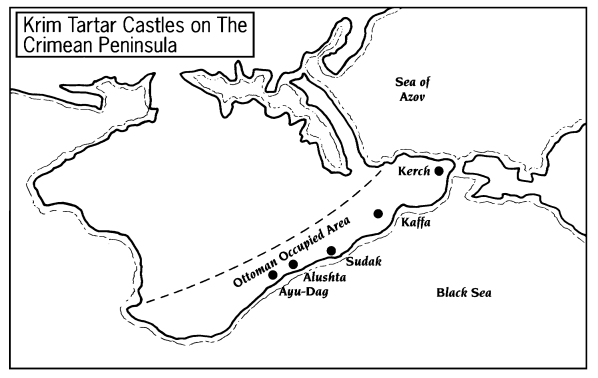
Also, as subjects of the Ottoman Porte, they had Turkish troops, in theory, on call, certainly this was the case at the fortress of Azov, although it was Krim Tartars who were expected to run patrols outside the city walls to protect its caravan trade from the Azov Tartar raids. An elite personal bodyguard, the Sekbans, was also employed by Mengli-Girey and was subsidized by the Sultan, who also had it equipped with muskets.
The Krim held fortresses were in the main located on the Black Sea coast of the Crimean Peninsula (Alushta, Ayu-Dag, Kaffa, Kerch and Sudak) and therefore had little influence in these campaigns.
Tartar Flag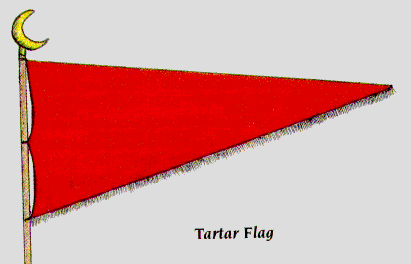
A Traditional Tartar double horsetail standard or "tug".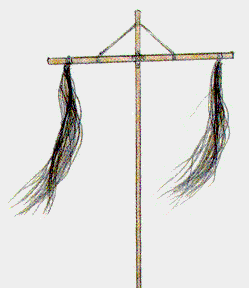
The Tartar flag is taken from a contemporary woodcut. The colours are not known, those used in Tartar flags were reds, greens, black and blue.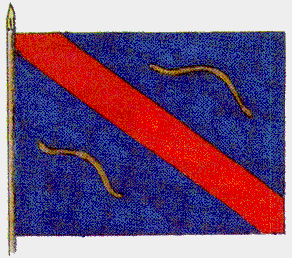
The Tartar method of drawing a bow string was with a thumb-ring. This method was used in most parts of Asia from Turkey to Korea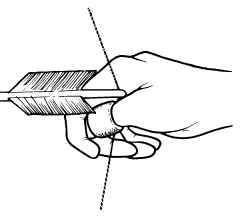
Archer's bronze thumb-ring from Golden Horde mid 13th to 16th century.